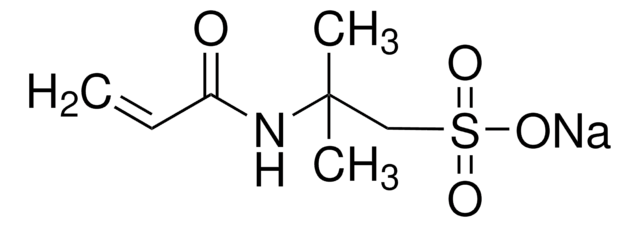Products may be shipped at a different temperature than the recommended long-term storage temperature. If the product quality is sensitive to short-term exposure to conditions other than the recommended long-term storage, it will be shipped on wet or dry-ice. If the product quality is NOT affected by short-term exposure to conditions other than the recommended long-term storage, it will be shipped at ambient temperature. As shipping routes are configured for minimum transit times, shipping at ambient temperature helps control shipping costs for our customers. For more information, please refer to the Storage and Transport Conditions document: https://www.sigmaaldrich.com/deepweb/assets/sigmaaldrich/marketing/global/documents/316/622/storage-transport-conditions-mk.pdf
191973
Poly(2-acrylamido-2-methyl-1-propanesulfonic acid) solution
average Mw 2,000,000, 15 wt. % in H2O
Synonym(s):
2-Acrylamido-2-methyl-1-propanesulfonic acid polymer, 2-Acrylamido-2-methylpropanesulfonic acid polymer, PolyAMPS
About This Item
Recommended Products
mol wt
average Mw 2,000,000
Quality Level
concentration
15 wt. % in H2O
pH
1.0-3.0
surface tension
79.8 dyn/cm, 1 wt. %
viscosity
~200,000 cP, Brookfield RVT(lit.)
acid number
41‑45 mg KOH/g
SMILES string
CC(C)(CS(O)(=O)=O)NC(=O)C=C
InChI
1S/C7H13NO4S/c1-4-6(9)8-7(2,3)5-13(10,11)12/h4H,1,5H2,2-3H3,(H,8,9)(H,10,11,12)
InChI key
XHZPRMZZQOIPDS-UHFFFAOYSA-N
Related Categories
Application
Features and Benefits
Signal Word
Danger
Hazard Statements
Precautionary Statements
Hazard Classifications
Skin Corr. 1A
Storage Class Code
8A - Combustible corrosive hazardous materials
WGK
WGK 3
Flash Point(F)
Not applicable
Flash Point(C)
Not applicable
Choose from one of the most recent versions:
Already Own This Product?
Find documentation for the products that you have recently purchased in the Document Library.
Customers Also Viewed
Articles
We present an article that discusses two applications in particular; first, using these layers as polyelectrolyte membranes to control permeability.
-
How is shipping temperature determined? And how is it related to the product storage temperature?
1 answer-
Helpful?
-
-
How can I determine the shelf life / expiration / retest date of this product?
1 answer-
If this product has an expiration or retest date, it will be shown on the Certificate of Analysis (COA, CofA). If there is no retest or expiration date listed on the product's COA, we do not have suitable stability data to determine a shelf life. For these products, the only date on the COA will be the release date; a retest, expiration, or use-by-date will not be displayed.
For all products, we recommend handling per defined conditions as printed in our product literature and website product descriptions. We recommend that products should be routinely inspected by customers to ensure they perform as expected.
For products without retest or expiration dates, our standard warranty of 1 year from the date of shipment is applicable.
For more information, please refer to the Product Dating Information document: https://www.sigmaaldrich.com/deepweb/assets/sigmaaldrich/marketing/global/documents/449/386/product-dating-information-mk.pdfHelpful?
-
Active Filters
Our team of scientists has experience in all areas of research including Life Science, Material Science, Chemical Synthesis, Chromatography, Analytical and many others.
Contact Technical Service




![Poly[bis(2-chloroethyl) ether-alt-1,3-bis[3-(dimethylamino)propyl]urea] quaternized, solution 62 wt. % in H2O](/deepweb/assets/sigmaaldrich/product/structures/139/843/f0b4a2ac-de44-4fb5-ab36-a700daaf8aa5/640/f0b4a2ac-de44-4fb5-ab36-a700daaf8aa5.png)







![Poly[(2-ethyldimethylammonioethyl methacrylate ethyl sulfate)-co-(1-vinylpyrrolidone)] average Mw <1,000,000 by GPC, 20 wt. % in H2O](/deepweb/assets/sigmaaldrich/product/structures/334/533/03fcaede-76a6-4b5a-a992-9565ea1ace4a/640/03fcaede-76a6-4b5a-a992-9565ea1ace4a.png)

